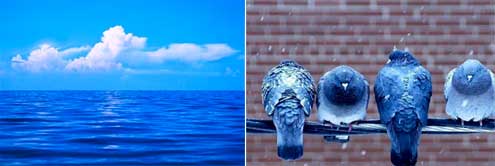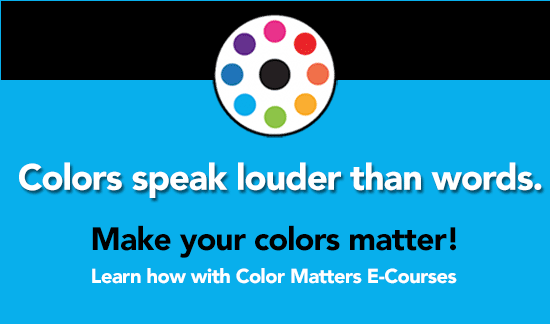Blue
The Meanings of Blue

Blue is the favorite color of all people. It’s nature’s color for water and sky, but is rarely found in fruits and vegetables. Today, blue is embraced as the color of heaven and authority, denim jeans and corporate logos. It is cold, wet, and slow as compared to red’s warmth, fire, and intensity.
Blue has more complex and contradictory meanings than any other color. These can be easily explained by pinpointing by the specific shade of blue.

Dark blue: trust, dignity, intelligence, authority
Bright blue: cleanliness, strength, dependability, coolness
(The origin of these meanings arise from the qualities of the ocean and inland waters, most of which are more tangible.)
Light (sky) blue: peace, serenity, ethereal, spiritual, infinity
(The origin of these meanings is the intangible aspects of the sky.)
Most blues convey a sense of trust, loyalty, cleanliness, and understanding. On the other hand, blue evolved as symbol of depression in American culture. “Singing the blues” and feeling blue” are good examples of the complexity of color symbolism and how it has been evolved in different cultures.
Global Meanings of Blue

Blue's global similarities are significant:
Blue is the #1 favorite color of all people.
53% of the flags in the world contain blue.
Blue is the most commonly used color in corporate identity.
A dark blue suit is professional business attire.
Blue jeans are worn all over the world.
Aristocracy is blue-blooded in all European languages.
Unique Meanings of Blue in Different Cultures
Greeks believe that blue wards off "the evil eye.
The English “to feel blue” has no equivalent in other languages while in German “blau sein” (literally: to be blue) means to be drunk or in Russian “голубой” (literally: light blue) means to be homosexual.
Dark blue is the color of mourning in Korea.
The god Krishna has blue skin.
Shades of blue are described as shallow or deep instead of light or dark in China.
Blue is for a baby girl; pink for a baby boy in Belgium.
“Prince Charming” is called “The Blue Prince” in Italy and Spain.
Designing with Blue
Blue ranks so high as a favorite color that you can’t go wrong if you use blue. However, blue can be over-used and may wind up a design cliché if used alone. Combining blue with another color creates a more creative effect.
Blue is the only color which maintains its own character in all its tones... it will always stay blue;” Raoul Dufy, French Fauvist Painter, 1877-1953
from Color Matters
How Blue Affects Vision
Blue is sharply refracted by the eyes. This causes the lens to flatten and to push the blue image back. We perceive that blue areas are receding and smaller.
The same refraction causes visual fog if used excessively in interior spaces.
Myths about the Effects of Blue on the Body
 Unfortunately, there are many “pseudo studies” that suggest that blue rooms can calm or depress people. Under closer scrutiny none of these have stood up. However, there’s lots of money to be made telling people otherwise.
Unfortunately, there are many “pseudo studies” that suggest that blue rooms can calm or depress people. Under closer scrutiny none of these have stood up. However, there’s lots of money to be made telling people otherwise.
Some Truths about the Effects of Blue
Blue has very few connections to taste or smell. Therefore it may act as an appetite suppressant. (Find out more about how blue affects appetite at Color & Appetite Matters)
Tidbits – Points to Ponder
Supposing the color blue was removed from the world, specifically the sea and sky ... what color would fill the void?
More about blue at Color Matters:
Blue - The Versatile Color
A Color That's Worth $80,000,000
Explore the meanings of more colors!
Also from Color Matters





